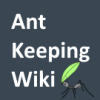I have been meaning to turn this post into its own topic for a few years now.
Taken from my Pogonomyrmex tenuispinus journal:
In mid-July to late August, I go out to their area after a summer storm to collect males. If I'm lucky enough to get out there the day after a decent shower, both males and females leave the nest between 6:30AM-7:30AM. The males leave first and the females follow 10-15 minutes later. I've not found a lek, because the terrain is very challenging. If I find dealate females, I also bring a few back. I collect only what I need for that year's project and nothing more.
The day after I return with the males, I water the parent colony and the female alates arise the next morning. I collect them and put them with the males in a separate tank with soil heated from above by a incandescent lamp. They all gather under the lamp to get their body temperature up to optimum. Then they all begin to run around in a frenzy. The males latch-onto the females who struggle, ensuring only the strongest males will be successful. The first mating takes place and is completed within a couple of minutes. The females try to depart, but can only go so far before another male grabs onto them and mates as well. I may leave them in the tank for the entire day, ensuring they are fertilized many times which should sustain fertility for a lifetime. I suspect the females depart the lek after the first or second mating in the wild, as their hillside gets extremely hot very quickly in the morning and they need to find shelter to survive.
So, the only triggers are water for the parent colony the day before and an overhead lamp. If I turn-off the lamp, the mating frenzy ceases after 10-15 minutes as their body temperature drops sufficiently. The whole affair is a matter of timing and replicating the conditions they experience in the wild.
















